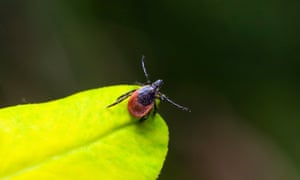
‘To be honest,” enthuses Dr Tim Brooks, “it’s a fascinating disease.” As head of the Rare and Imported Pathogens laboratory at Public Health England, trying to solve the growing problem of Lyme disease (and other bugs, such as ebola) is his vocation. Lyme disease – a bacterial infection spread by infected ticks – is a particularly complex puzzle, with little reliable data available so far. It can appear in numerous forms, occasionally causing long-term neurological symptoms that could be mistaken for other conditions, such as multiple sclerosis or motor neurone disease.
Following a surge in cases this year – thought to be due to increased public awareness and rising numbers of the ticks that spread the disease – the Department of Health plans to install a network of experts around the country to support GPs and hospital staff who are unfamiliar with the disease. Meanwhile, beware misinformation online. For a start, the strains differ according to country, and no, you can’t catch it from other people. An estimated 2,000 to 3,000 people in the UK come down with it each year, and most cases are straightforward to treat. Complications only arise in a minority of cases, if caught late. Here’s how to best avoid being affected.
Be tick aware
These tiny arachnids have a natural anesthetic in their saliva that means most people don’t notice them burrowing into their skin to feed on blood. The critters need to be attached for 16 hours before they will transmit the disease, so it’s worth checking yourself and any children – scalps and all – after being out enjoying nature, especially in the summer. Covering up, and using insect repellent, can help deter them. They don’t jump, but rather sit on tall grass or plants, waiting for potential hosts to brush against them. While well-fed adult ticks – which resemble ears of sweetcorn or mini, eight-legged balloons – look the most alarming, and will have had a greater chance to pick up Lyme, the minute dot-like nymphs (the stage between larva and adult ticks) are more likely to bite you.
Once a tick has latched on to a host, the trick is to pull it out without squeezing secretions into the wound, thus increasing the chance of infection – Lyme disease isn’t the only bug they carry – or leaving their barbed mouthparts in the wound. Ideally, use a tick removal tool to twist and lever it out, or carefully use pointed tweezers, as close to the skin as possible, to firmly tug outwards, without twisting. Afterwards, clean the wound and don’t panic. “The instance of infection in the UK varies from zero in some places, to 7-8% in others,” says Brooks. However, this isn’t neatly divided into broad geographical areas, but rather little pockets.
Symptoms
Responses to the disease vary from person to person. Some will never feel any effects. In others, it may clear up quickly on its own. The most common first signs – which can take between three and 30 days to appear – are a target-shaped rash around the bite, and flu-like symptoms. In the UK, according to Brooks, probably 25-30% of cases don’t present a rash. If you do get any of these symptoms after a tick bite, tell your GP, who will test your blood. Blood tests can come out negative in early stages of infection, so if Lyme is still suspected, retesting may be necessary.
“Two weeks of antibiotics is usually quite enough,” says Brooks. “Most people who are treated early on get better, as long as they complete the course.”
If you didn’t notice the bite or a rash, and perhaps thought nothing of feeling under the weather for a few days, then there’s a slim chance that longer-term complications may occur. “Children often get Bell’s palsy [weakness or paralysis to one side of the face],” says Brooks, “while adults get symptoms relating to the distribution of one nerve or another, or a kind of meningitis.” Concentration and memory problems have been reported, along with headaches, numbness and pain in the limbs. Arthritis is a common complication in the US, but is relatively rare in the UK. Rarer still, says Brooks, but affecting some people, is inflammation of part of the heart.
Of course, if these symptoms are presented, especially with no knowledge of a tick bite, says Brooks, “we have a duty to investigate those people, to check they don’t have multiple sclerosis and motor neurone disease, which are rather more serious and need different treatment”. And with chronic headaches and disturbances in sensory functions, a brain tumour would need to be ruled out.
Late treatment
If symptoms are missed early on, or don’t arise until later, Lyme is harder to treat. After a month-long treatment with intravenous antibiotics, most people will recover, although they may have symptoms for up to a year. Some will need a second treatment, and, says Brooks, “there is some evidence that a very small proportion of those will go on to get more symptoms”. This could be because the organism wasn’t eliminated, or because the organism damaged nerve tissue, which may or may not slowly recover, depending on what type it is. There’s also evidence that the disease can trigger an autoimmune reaction.
Finally, even when clear of the disease, says Brooks, “the organism is very clever and can change the way it looks to the immune system, so you can get it again and again”. You would have to be incredibly unlucky to catch it once, though, let alone twice, and none of this should prevent anyone enjoying parks and woods.
[Source:-.The.Gurdian]
